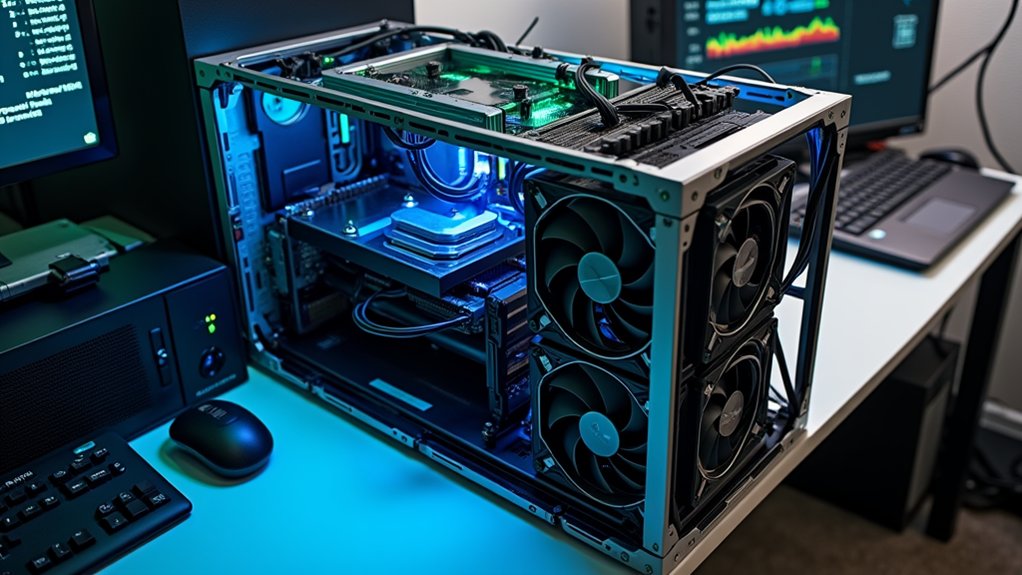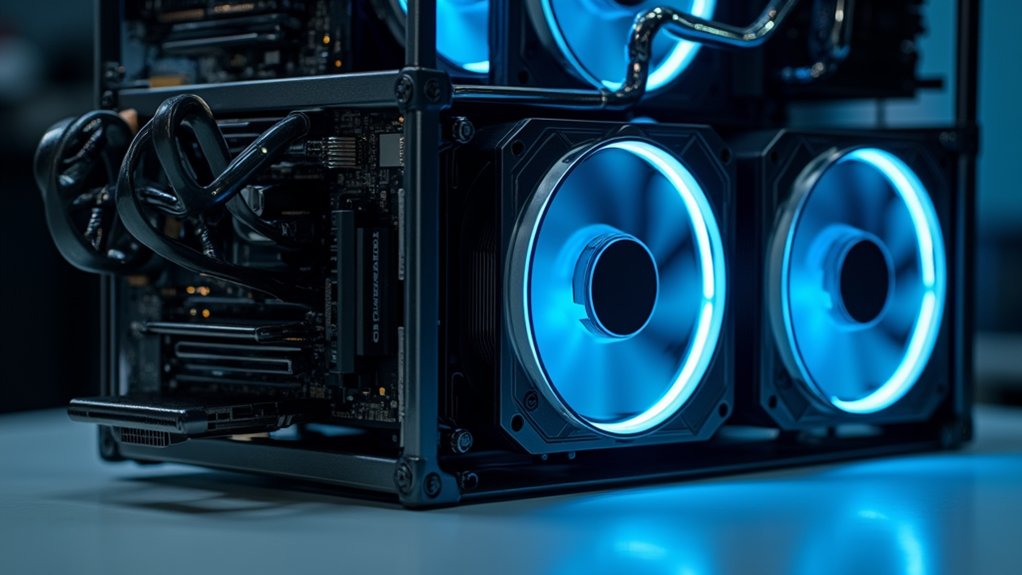Building a crypto mining rig requires substantial initial investment in high-performance GPUs, specialized motherboards with multiple PCIe slots, and robust power supply units capable of handling significant electrical loads. Effective operations depend on balancing hardware costs against potential returns, implementing efficient cooling systems, and utilizing specialized mining software optimized for specific cryptocurrencies. Miners must continuously monitor performance metrics, adapt to market fluctuations, and secure access to affordable electricity to maintain profitability. Further exploration reveals critical considerations for long-term sustainability in this competitive landscape.

Constructing a profitable cryptocurrency mining rig requires meticulous planning, technical expertise, and substantial initial investment, all of which must be carefully balanced compared to potential returns in an increasingly competitive digital mining landscape.
The foundation of any effective mining operation centers on the careful selection of graphics processing units (GPUs), which serve like the primary computational engines for solving the complex cryptographic equations that underpin blockchain validation processes. Unlike conventional computing systems, mining rigs prioritize raw computational power over general processing capabilities, necessitating motherboards specifically designed to accommodate multiple GPUs through PCIe slots and risers, while CPU and RAM requirements remain relatively minimal.
Mining rigs demand GPUs with exceptional computational strength, leaving traditional processing considerations secondary to pure cryptographic horsepower.
Power supply selection represents a critical decision point in the assembly process, as mining systems typically draw significant electrical current to operate multiple high-performance GPUs simultaneously, with insufficient wattage potentially resulting in system instability or component failure. Mining profitability hinges significantly on access to cheap sustainable electricity, which directly impacts the overall return on investment for miners.
The physical architecture of mining rigs deviates substantially from traditional computer cases, with open-frame chassis designs predominating the market due to their superior airflow characteristics, elevated GPU positioning via PCIe risers, and the thermal separation of critical components. Mining rigs with higher hash rates directly contribute to increased cryptocurrency mining efficiency and potential profitability. These structural considerations directly impact thermal management, which remains paramount in maintaining operational efficiency and hardware longevity.
Cooling systems for mining operations generally incorporate multiple high-volume fans exceeding 140mm in diameter, supplemented by appropriately applied thermal interfaces and heat sinks to dissipate the considerable heat generated during continuous operation.
The software ecosystem supporting cryptocurrency mining operations typically favors Linux-based operating systems for their stability characteristics, with specialized mining applications configuring the interaction between hardware resources and selected mining pools.
Successful implementation requires careful attention to the complex interplay between hardware capabilities, power consumption metrics, cooling efficiency, and software optimization, all of which must be continuously monitored and calibrated to maintain competitive mining yields in an environment characterized by fluctuating cryptocurrency valuations and steadily increasing network difficulty parameters.
Frequently Asked Questions
How Much Electricity Will My Mining Rig Consume Monthly?
A standard mining rig with six GPUs typically consumes approximately 1 kW continuously, resulting in 720 kWh monthly (1 kW × 24 hours × 30 days).
With power-efficient configurations, consumption might decrease to 600-650 kWh monthly.
When accounting for cooling requirements, which can add up to 30% additional energy usage, total consumption often reaches 800-950 kWh monthly, varying based on hardware specifications, ambient temperature conditions, and the specific cryptocurrency being mined.
Is Mining Still Profitable With Current Cryptocurrency Prices?
Cryptocurrency mining profitability remains highly variable, depending primarily on electricity costs, hardware efficiency, and market conditions.
Following Bitcoin's April 2024 halving, profit margins have compressed considerably, with operations accessing electricity below $0.05/kWh typically maintaining viability.
Miners utilizing renewable energy sources, implementing heat recycling systems, or diversifying into altcoin mining generally demonstrate superior financial robustness.
Institutional miners increasingly supplement revenue through AI co-hosting arrangements, creating additional income streams beyond traditional block rewards.
What's the Expected ROI Timeframe for a New Mining Rig?
The ROI timeframe for a new mining rig varies greatly based on hardware selection, electricity costs, and market conditions.
For the Antminer S19K Pro ($768), current calculations indicate a payback period of approximately 280 days at $68,000 BTC and $0.045/kWh rates.
This payback period could potentially decrease to 142 days should Bitcoin reach $100,000.
Higher electricity costs considerably extend this timeline, while technological obsolescence remains a critical factor in ROI calculations.
How Loud Are Mining Rigs During Continuous Operation?
Mining rigs typically generate 70-90 dB of noise during continuous operation, comparable to vacuum cleaners or busy traffic.
This noise level increases logarithmically with additional units, with ten rigs boosting output by approximately 10 dB.
Industrial mining farms, utilizing hundreds of units, can exceed 95 dB, creating disturbances audible up to one mile away.
Mitigation strategies include specialized fan upgrades, immersion cooling, and acoustic panels, which can collectively reduce noise by up to 25 dB.
Are There Legal Restrictions on Home Crypto Mining Operations?
Legal restrictions on home crypto mining operations vary greatly by jurisdiction, with some localities implementing outright bans, while others have enacted protective "Right-to-Mine" legislation.
New York's prohibition on Proof-of-Work mining contrasts with states like Arkansas and Montana, which safeguard mining rights.
Additionally, local zoning ordinances frequently impose constraints related to noise levels and energy consumption, regardless of state-level regulations.
Small-scale miners must consider taxation consequences, since mining rewards constitute taxable income in most jurisdictions.









